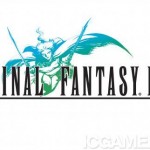Powet Alphabet: H is for Handheld Gaming
by William Talley, filed in Games, Powet Alphabet on Aug.22, 2010
Since the alphabet is the building block of our language, the Powet Alphabet is the building block of what makes us geeks.
 In the short time they had been around, manufacturers took steps to make video games available in as many formats as possible. After their arcade origins, games were made available on home computers, and consoles. After making consoles which allowed interchangeable cartridges, the next logical step would be to make games that you could take with you on the go. From the tabletop electronic games of the 60s and 70s to the Nintendo DS, Sony PSP, and everything else in between, there has been no better way to pass the time.
In the short time they had been around, manufacturers took steps to make video games available in as many formats as possible. After their arcade origins, games were made available on home computers, and consoles. After making consoles which allowed interchangeable cartridges, the next logical step would be to make games that you could take with you on the go. From the tabletop electronic games of the 60s and 70s to the Nintendo DS, Sony PSP, and everything else in between, there has been no better way to pass the time.
Origins
 Handheld gaming consoles as we know them are basically the synthesis of the old table top electronic games from the 60s and the electronic LCD calculators, which were increasingly becoming popular. These table top games were referred to as non-video electronic games and non TV games. In 1976, Mattel started a line of handheld sports titles, after then-marketing director Michael Katz challenged his development team to create a game the size of a calculator. The first release was 1977’s Auto Race, which was the first electronic game that was entirely digital. It was quite primitive. There were no buttons beside the controls to move the car and the on/off switch. Your car was represented by a blip on the screen, and you had to make it to the top of the screen 4 times (represented 4 laps) while avoiding the other cars. It wasn’t much, but Mattel followed it up with football. The games became a resounding success, and other companies such as Coleco, Parker Brothers, and Bandai followed suit. One company, Milton Bradley, took a huge step forward. In 1979, they released the Smith Engineering-developed Microvision, the first handheld game system with interchangeable cartridges. The unit was a moderate success, though it would eventually meet its demise due to the lack of available games, faulty hardware, a small screen, and the lack of support by software developers.
Handheld gaming consoles as we know them are basically the synthesis of the old table top electronic games from the 60s and the electronic LCD calculators, which were increasingly becoming popular. These table top games were referred to as non-video electronic games and non TV games. In 1976, Mattel started a line of handheld sports titles, after then-marketing director Michael Katz challenged his development team to create a game the size of a calculator. The first release was 1977’s Auto Race, which was the first electronic game that was entirely digital. It was quite primitive. There were no buttons beside the controls to move the car and the on/off switch. Your car was represented by a blip on the screen, and you had to make it to the top of the screen 4 times (represented 4 laps) while avoiding the other cars. It wasn’t much, but Mattel followed it up with football. The games became a resounding success, and other companies such as Coleco, Parker Brothers, and Bandai followed suit. One company, Milton Bradley, took a huge step forward. In 1979, they released the Smith Engineering-developed Microvision, the first handheld game system with interchangeable cartridges. The unit was a moderate success, though it would eventually meet its demise due to the lack of available games, faulty hardware, a small screen, and the lack of support by software developers.
Gunpei Yokoi and Tiger
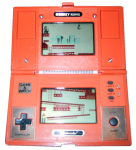 Even before, during, and after the great video game crash, the handheld video game scene was becoming more prominent. Nintendo’s Gunpei Yokoi in particular made significant strides not only in the field but in video games in general. Inspired by the popularity of LCD calculators, he created the Game and Watch series, which allowed a single game to be played on a double screen unit that included a clock and an alarm. These units were the predecessors to the Game Boy, Nintendo DS, and virtually everything else Nintendo did (By the way, that pic to the left look familiar to anyone?). Particularly, the cross-shaped directional pad which Yokoi invented for use to control on-screen characters made its way into the design of the Nintendo Entertainment System, Game Boy, Super Nintendo, and other consoles. It’s important to note that Nintendo’s Game and Watch units are not to be confused with Nelsonic’s Game Watch series which were literally games within watches. Interestingly enough however, among them included Nintendo properties such as Mario, Zelda, and Donkey Kong.Tiger electronics was another pioneer in the field. The started doing electronic toys in the early 80s with the K28 learning computer. Throughout the 80s and 90s, they produced a number of handheld games based on everything from movies, to TV shows, to even console games. Thus, players who couldn’t afford to play games like Mega man 3 and Double Dragon could play what essentially was a crippled version of the game. Both the Game and Watch series and Tiger’s games made use of primitive LCD screens with preset sprites and limited animation if any at all. Still, they were light years more advanced than earlier, and things were going to get better.
Even before, during, and after the great video game crash, the handheld video game scene was becoming more prominent. Nintendo’s Gunpei Yokoi in particular made significant strides not only in the field but in video games in general. Inspired by the popularity of LCD calculators, he created the Game and Watch series, which allowed a single game to be played on a double screen unit that included a clock and an alarm. These units were the predecessors to the Game Boy, Nintendo DS, and virtually everything else Nintendo did (By the way, that pic to the left look familiar to anyone?). Particularly, the cross-shaped directional pad which Yokoi invented for use to control on-screen characters made its way into the design of the Nintendo Entertainment System, Game Boy, Super Nintendo, and other consoles. It’s important to note that Nintendo’s Game and Watch units are not to be confused with Nelsonic’s Game Watch series which were literally games within watches. Interestingly enough however, among them included Nintendo properties such as Mario, Zelda, and Donkey Kong.Tiger electronics was another pioneer in the field. The started doing electronic toys in the early 80s with the K28 learning computer. Throughout the 80s and 90s, they produced a number of handheld games based on everything from movies, to TV shows, to even console games. Thus, players who couldn’t afford to play games like Mega man 3 and Double Dragon could play what essentially was a crippled version of the game. Both the Game and Watch series and Tiger’s games made use of primitive LCD screens with preset sprites and limited animation if any at all. Still, they were light years more advanced than earlier, and things were going to get better.
The race heats up
1989 saw the North American debut of two handheld systems, both of which would change the shape of the industry: Nintendo’s Game Boy and Atari’s Lynx. The former system was the brainchild of Gunpei Yokoi. Although the Game Boy had a monochrome green-and-black LCD screen, it’s graphics were miles above anything else seen at the time, almost resembling NES games in terms of animation and detail. The unit itself included a headphone jack to listen to music in stereo, and an external power supply jack for an AC adapter or rechargeable battery pack. Two players could compete against each other using the gamelink, which was sold separately. It was bundled with the popular puzzle game Tetris, which became one of the highest selling games on a portable system. The system went through a number of revisions, either focusing on the color of the system, to its size. They eventually released a color version of the system, but we’ll get to that later.
 The latter system began life as Epyx’s Handy Game, until the company was bought out by Atari and the Handy Game was re-dubbed the Lynx. Along with being the world’s first handheld system with a color display, the Lynx also packed in several nice features as well. The graphics were more advanced than anything else seen at time, featuring sprite scaling techniques that were almost on par with the emerging 16-bit systems. It also had a backlit display, and players could flip the unit upside down to play it left-handed. Players could link up to 17 other units to play multiplayer. Even with these features, the Lynx’s high price point ($189.99 vs the Game Boy’s 89.99 price tag), lousy battery life (six AA batteries gave the system somewhere between 4 – 5 hours of gameplay – keep in mind that this was before rechargeable batteries became the norm), and lack of support from third party developers and publishers (mainly due to Nintendo’s heavy handed licensing policies and the fact Atari couldn’t’t move enough units to attract third parties) caused the Lynx to be edged out by Nintendo. Atari slashed the unit’s price tag down to $99 in 1991, but they still couldn’t move very many units. In 1994, Atari shifted its focus away from the Lynx to the Jaguar. Although the system was pretty much dead at this point (losing out to both the Game Boy and Sega’s Game Gear), developers continued to make software for it, and at the end of the decade, Hasbro released the rights to make games for both the Lynx and the Jaguar to public domain, gaining the systems popularity amongst homebrew and independent developers. New games have been released for the system as recently as 2009, when Super Fighter Team released the horizontal side scrolling shooter Zaku.
The latter system began life as Epyx’s Handy Game, until the company was bought out by Atari and the Handy Game was re-dubbed the Lynx. Along with being the world’s first handheld system with a color display, the Lynx also packed in several nice features as well. The graphics were more advanced than anything else seen at time, featuring sprite scaling techniques that were almost on par with the emerging 16-bit systems. It also had a backlit display, and players could flip the unit upside down to play it left-handed. Players could link up to 17 other units to play multiplayer. Even with these features, the Lynx’s high price point ($189.99 vs the Game Boy’s 89.99 price tag), lousy battery life (six AA batteries gave the system somewhere between 4 – 5 hours of gameplay – keep in mind that this was before rechargeable batteries became the norm), and lack of support from third party developers and publishers (mainly due to Nintendo’s heavy handed licensing policies and the fact Atari couldn’t’t move enough units to attract third parties) caused the Lynx to be edged out by Nintendo. Atari slashed the unit’s price tag down to $99 in 1991, but they still couldn’t move very many units. In 1994, Atari shifted its focus away from the Lynx to the Jaguar. Although the system was pretty much dead at this point (losing out to both the Game Boy and Sega’s Game Gear), developers continued to make software for it, and at the end of the decade, Hasbro released the rights to make games for both the Lynx and the Jaguar to public domain, gaining the systems popularity amongst homebrew and independent developers. New games have been released for the system as recently as 2009, when Super Fighter Team released the horizontal side scrolling shooter Zaku.
1991 saw the release of NEC’s TurboExpress, a unit that allowed players to play the ultra slim Turbografx-16 Hucards on the go. All three systems had link cables to play 2 player games, although in the case of the TurboExpress, very few TG-16 games had been designed with TurboExpress co-op in mind. The system also had a TV tuner enabling the system to be turned into a color TV. Despite these advantages, the TurboExpress was wrought with problems from the get go. The game’s library was based on that of a system that wasn’t getting much third-party support anyway, and there were several hardware problems with the unit too. Thanks to the cheap capacitors used in the hardware, the systems suffered sound failure, sometimes even in new units. The LCD screen tended to suffer from a high rate of pixel failure, many times showing up in new units as well. Also, many of the on-screen text fonts were obviously meant to be seen on a television, not on a small 3 – 5 inch screen, so much of the text was hard to read. Some of the HuCards saved data to the internal memory of the TG-16 or TurboDuo. Since the TurboExpress didn’t have any internal memory, it was impossible to save these games. As cool as it would be to play your TG-16 HuCards on the go, it would seem obvious that NEC didn’t exactly think this through through enough. The $299.99 price tag (which was lowered down to $199.99 by 1992) and even worse battery life (six AA for three hours) didn’t exactly do it any favors either. It was discontinued around the same time the TurboDuo was on its last legs.
Despite having a monochrome screen however, the Game Boy managed to outperform both the TurobExpress and the Lynx. The following year saw the release of yet another system, released by one of Nintendo’s fiercest competitors.
Sega Gets It’s Game in Gear
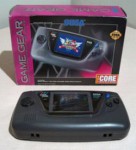 During the early 90s, Sega’s Genesis was catching fire, gaining the lead on Nintendo. However, Sega realized that even if they were to surpass Nintendo in the home console market, it wouldn’t mean anything if Nintendo still had a strong lead in the portable gaming market. Thus in 1992, Sega released the Game Gear in North America. Like the TurboExpress and Lynx, it was a color unit. Since the architecture of the Game Gear and Master System were similar, it was easy for Master System titles to be ported down to Game Gear. There was even am adapter, called the Mastergear Converter which allowed Master System games to be played on the Game Gear. Like the TurboExpress, there was also a TV converter for the system. The Game Gear wasn’t popular in Japan (which wasn’t surprising, as the Genesis wasn’t exactly doing well over there either), although in the U.S, they managed to gain a surprising market share thanks to an aggressive marketing campaign against Nintendo’s Game Boy, one which was similar to the Genesis vs NES/SNES marketing campaign. The majority of their ads centered around Game Gear’s color screen vs Nintendo’s ‘spinach green’ (as one ad called it) monochrome screen. Even so, Nintendo’s Game Boy managed to outsell the Game Gear thanks to (wait for it) a high price tag ($149) and lousy battery life (5 – 6 hours) on 6 AA batteries. Support for the system ended in 1997, which was pretty much the same time Sega ended support for the Genesis as well. While the Game Gear failed to outsell the Game Boy, it did do better than every other portable system that was competing with Game Boy.
During the early 90s, Sega’s Genesis was catching fire, gaining the lead on Nintendo. However, Sega realized that even if they were to surpass Nintendo in the home console market, it wouldn’t mean anything if Nintendo still had a strong lead in the portable gaming market. Thus in 1992, Sega released the Game Gear in North America. Like the TurboExpress and Lynx, it was a color unit. Since the architecture of the Game Gear and Master System were similar, it was easy for Master System titles to be ported down to Game Gear. There was even am adapter, called the Mastergear Converter which allowed Master System games to be played on the Game Gear. Like the TurboExpress, there was also a TV converter for the system. The Game Gear wasn’t popular in Japan (which wasn’t surprising, as the Genesis wasn’t exactly doing well over there either), although in the U.S, they managed to gain a surprising market share thanks to an aggressive marketing campaign against Nintendo’s Game Boy, one which was similar to the Genesis vs NES/SNES marketing campaign. The majority of their ads centered around Game Gear’s color screen vs Nintendo’s ‘spinach green’ (as one ad called it) monochrome screen. Even so, Nintendo’s Game Boy managed to outsell the Game Gear thanks to (wait for it) a high price tag ($149) and lousy battery life (5 – 6 hours) on 6 AA batteries. Support for the system ended in 1997, which was pretty much the same time Sega ended support for the Genesis as well. While the Game Gear failed to outsell the Game Boy, it did do better than every other portable system that was competing with Game Boy.
Handheld vs Portable
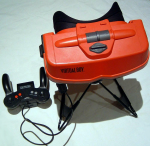 It should be noted that while all handhelds are portable, not all portable systems are handheld. Take your laptop for instance. You can take it with you, but you obviously can’t hold it in your hand. Lets consider 2 systems released by Nintendo and Sega during the mid 90s: Nintendo’s Virtual Boy and the Sega Multi-Mega, or as we knew it, the CDX. The CDX was one of many attempts to create a hybrid Genesis/Sega CD unit, although it’s price ($399) and short battery life kept it from being little more than an overpriced and over-sized CD player that could play video games (as long as you plugged it in and hooked it up to a TV of course). It wasn’t exactly designed with 32X compatibility in mind. Although the unit did technically work with the add-on, the combination caused a number of problems. At the time of the system’s release, consumers were pretty much losing interest in the Sega CD anyway. The Virtual Boy was the world’s first true 3D gaming system, although it’s colors were only red and black. You had to sit it on a flat surface and peer into the headset while holding the dual gripped controller. It didn’t do very well at all despite several price drops, and only 14 games were ever released for the system in the U.S. It’s critical failure was believed to be the reason Gunpei Yokoi was forced to leave Nintendo, although many speculate that the system had been rushed to the market so Nintendo could focus its resources on N64 development. Still, even the Virtual Boy made its impact in a way, as the dual-control pad design is similar to the design of control pads with dual analog sticks.
It should be noted that while all handhelds are portable, not all portable systems are handheld. Take your laptop for instance. You can take it with you, but you obviously can’t hold it in your hand. Lets consider 2 systems released by Nintendo and Sega during the mid 90s: Nintendo’s Virtual Boy and the Sega Multi-Mega, or as we knew it, the CDX. The CDX was one of many attempts to create a hybrid Genesis/Sega CD unit, although it’s price ($399) and short battery life kept it from being little more than an overpriced and over-sized CD player that could play video games (as long as you plugged it in and hooked it up to a TV of course). It wasn’t exactly designed with 32X compatibility in mind. Although the unit did technically work with the add-on, the combination caused a number of problems. At the time of the system’s release, consumers were pretty much losing interest in the Sega CD anyway. The Virtual Boy was the world’s first true 3D gaming system, although it’s colors were only red and black. You had to sit it on a flat surface and peer into the headset while holding the dual gripped controller. It didn’t do very well at all despite several price drops, and only 14 games were ever released for the system in the U.S. It’s critical failure was believed to be the reason Gunpei Yokoi was forced to leave Nintendo, although many speculate that the system had been rushed to the market so Nintendo could focus its resources on N64 development. Still, even the Virtual Boy made its impact in a way, as the dual-control pad design is similar to the design of control pads with dual analog sticks.
Game Boy Grows Up
 During the mid to late 90s, the console race heated up and went into the 32 bit era. Although the Nintendo 64 was struggling to hold its own against the Sony Playstation and Sega Saturn, the Game Boy was doing better than ever due to the lack of any real competition at the time. Well scratch that, Tiger, the maker of all those handhelds from the 80s tried to enter the console market. After the horrific R-Zone (which was no different from their handheld LCD games save that now they were cartridge based), they tried again with 1997’s Game.com (that’s to be pronounced “Game Com”, not ‘Game Dot Com”). The system was geared towards an older audience PDA style features such features such as a stylus and touch screen. It could even be connected to a modem for limited connectivity. Though they had virtually no third party support, they obtained licenses to develop ports of console titles for the system. Thus the console featured games such as Duke Nukem and Resident Evil 2, although unsurprisingly, they were inferior to their console ports. It’s poor distribution and marketing (featuring a marketing spokesman being mobbed by angry gamers after declaring that the Game.Com plays more games than they had brain cells) led to its demise in 2000. Of course Sega tried one last time to be a contender in the handheld market with the release of the Sega Nomad, a unit which played Genesis titles. Of course this flopped as well, due to (say it with me) a high price tag and a low battery life. Not only that, the system was released at a time when consumer interest in the Sega Genesis was waning in favor of more advanced 32 bit systems. Nintendo meanwhile, finally went color with the Game Boy. Not only did it finally allow developers to make color games for the system, but it was backwardly compatible with older Game Boy games giving the system an instantly large library from the get go. The move was perfect to coincide with the increasing popularity of Nintendo’s Pokemon franchise. The system’s graphics were similar to the NES, and there were several sequels, remakes, and releases on the system. The port of Super Mario Brothers for the unit features an overworld map and a battery backup save feature, making it the definitive version of the game.
During the mid to late 90s, the console race heated up and went into the 32 bit era. Although the Nintendo 64 was struggling to hold its own against the Sony Playstation and Sega Saturn, the Game Boy was doing better than ever due to the lack of any real competition at the time. Well scratch that, Tiger, the maker of all those handhelds from the 80s tried to enter the console market. After the horrific R-Zone (which was no different from their handheld LCD games save that now they were cartridge based), they tried again with 1997’s Game.com (that’s to be pronounced “Game Com”, not ‘Game Dot Com”). The system was geared towards an older audience PDA style features such features such as a stylus and touch screen. It could even be connected to a modem for limited connectivity. Though they had virtually no third party support, they obtained licenses to develop ports of console titles for the system. Thus the console featured games such as Duke Nukem and Resident Evil 2, although unsurprisingly, they were inferior to their console ports. It’s poor distribution and marketing (featuring a marketing spokesman being mobbed by angry gamers after declaring that the Game.Com plays more games than they had brain cells) led to its demise in 2000. Of course Sega tried one last time to be a contender in the handheld market with the release of the Sega Nomad, a unit which played Genesis titles. Of course this flopped as well, due to (say it with me) a high price tag and a low battery life. Not only that, the system was released at a time when consumer interest in the Sega Genesis was waning in favor of more advanced 32 bit systems. Nintendo meanwhile, finally went color with the Game Boy. Not only did it finally allow developers to make color games for the system, but it was backwardly compatible with older Game Boy games giving the system an instantly large library from the get go. The move was perfect to coincide with the increasing popularity of Nintendo’s Pokemon franchise. The system’s graphics were similar to the NES, and there were several sequels, remakes, and releases on the system. The port of Super Mario Brothers for the unit features an overworld map and a battery backup save feature, making it the definitive version of the game.
 For the next several years, Nintendo’s only real competition came from Japan, as SNK entered the market with the Neo Geo Pocket and Bandai arrived with the Wonderswan. Although both systems had a decent library, they were both monochromatic portable systems released at a time when their biggest, and only competitor just released a COLOR system. Thus the following year, both systems released color iterations of their systems, with the Neo Geo Pocket color being made available in America. Both systems did almost everything right. They were available at low price points (69.95 for the NGPC and approximately $59 for the Wonderswan) and had good battery life. Both systems even had several high profile exclusives. The NGPC had SNK vs Capcom – Match of the Millennium and Card Fighters’ Clash while the Wonderswan saw remakes of Final Fantasy 1 and 2 (the ones that were ported to Game Boy Advance, PSP, and Playstation 1). However it just wasn’t enough in the end. The NGPC collapsed when SNK filed bankruptcy, and although the unit was advertised on TV and being sold at places such as Wal-Mart and Toys’R’Us, all unsold units were recalled. The Wonderswan began to collapsed when developer Square reconciled its relationship with Nintendo, thereby taking away the system’s competitive edge. Despite the release of the successor system the SwanCrystal, Bandai eventually dropped out of the portable system market and went back to being a third party publisher/developer.
For the next several years, Nintendo’s only real competition came from Japan, as SNK entered the market with the Neo Geo Pocket and Bandai arrived with the Wonderswan. Although both systems had a decent library, they were both monochromatic portable systems released at a time when their biggest, and only competitor just released a COLOR system. Thus the following year, both systems released color iterations of their systems, with the Neo Geo Pocket color being made available in America. Both systems did almost everything right. They were available at low price points (69.95 for the NGPC and approximately $59 for the Wonderswan) and had good battery life. Both systems even had several high profile exclusives. The NGPC had SNK vs Capcom – Match of the Millennium and Card Fighters’ Clash while the Wonderswan saw remakes of Final Fantasy 1 and 2 (the ones that were ported to Game Boy Advance, PSP, and Playstation 1). However it just wasn’t enough in the end. The NGPC collapsed when SNK filed bankruptcy, and although the unit was advertised on TV and being sold at places such as Wal-Mart and Toys’R’Us, all unsold units were recalled. The Wonderswan began to collapsed when developer Square reconciled its relationship with Nintendo, thereby taking away the system’s competitive edge. Despite the release of the successor system the SwanCrystal, Bandai eventually dropped out of the portable system market and went back to being a third party publisher/developer.
Nintendo Advances
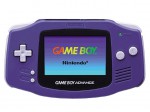 Left with no real competitors (at least in the U.S.), Nintendo’s Game Boy evolved further’ or rather I should say advance. In the summer of 2001, Nintendo released the Game Boy Advance, a 32 bit portable console. The unit was backwardly compatible with both Game Boy and Game Boy Color games, and the graphics were on par with the Super Nintendo in most cases. Much of the early lineup consisted of ports of older SNES titles such as Contra 3, Breath of Fire, and Super Mario World. Unfortunately some of them were hampered due to there only being 2 face buttons on the unit (as opposed to 4 on the original SNES controller). Contra 3 in particular, removed two of its stages due to the lack of buttons. There were also more original titles as well. Advance Wars’s brand of turn-based combat gained it a significant following among fans. The Mega Man Zero series was a Mega Man spin off that bought classic 2D gameplay to the new era. The system even saw ports of Doom and Wolfenstein 3D. A few years later, there was a redesign of the system called the Game Boy Advance SP which featured a backlit screen and a fliptop design. Even with the Game Boy Advance, cell phone gaming was becoming more popular among casual gamers, and hardware manufacturers were taking steps to make the medium successfully crossover into the mainstream, albeit to mixed results.
Left with no real competitors (at least in the U.S.), Nintendo’s Game Boy evolved further’ or rather I should say advance. In the summer of 2001, Nintendo released the Game Boy Advance, a 32 bit portable console. The unit was backwardly compatible with both Game Boy and Game Boy Color games, and the graphics were on par with the Super Nintendo in most cases. Much of the early lineup consisted of ports of older SNES titles such as Contra 3, Breath of Fire, and Super Mario World. Unfortunately some of them were hampered due to there only being 2 face buttons on the unit (as opposed to 4 on the original SNES controller). Contra 3 in particular, removed two of its stages due to the lack of buttons. There were also more original titles as well. Advance Wars’s brand of turn-based combat gained it a significant following among fans. The Mega Man Zero series was a Mega Man spin off that bought classic 2D gameplay to the new era. The system even saw ports of Doom and Wolfenstein 3D. A few years later, there was a redesign of the system called the Game Boy Advance SP which featured a backlit screen and a fliptop design. Even with the Game Boy Advance, cell phone gaming was becoming more popular among casual gamers, and hardware manufacturers were taking steps to make the medium successfully crossover into the mainstream, albeit to mixed results.
Nokia Gets Dis-N-Gaged
 Since their creation in the 80s, cellphones were slowly and increasingly starting to modernize and towards the end of the 90s, people wanted more out of their cell phones. Things such as calendars, calculators, and contact storage were being added, and in 1997, Nokia bought games to the cell phone for the first time via a port of the game Snake. Thanks to its popularity, it came pre-installed on many Nokia phones. In 2003, Nokia made an attempt at a cell phone based gaming platform with the N-Gage. It showed a lot of promise, as the unit included features such as MP3 player and an FM radio along with bluetooth connectivity for internet and multiplayer. Unfortunately, right out the gate there were problems. The system’s $299 price tag just didn’t make it an attractive competitor to the Game Boy Advance which was selling for less than a third of what Nokia was asking for, especially with Nokia’s scant library of games vs the dozens that were already available for the GBA (and that isn’t mentioning the hundreds that were already available for the Game Boy and Game Boy color. From a game system standpoint, a clunky design (which among other things required players to remove the battery color to change the game cartridge) hurt the system’s image and the phone keypad face buttons don’t translate well to a video game console. From a cell phone standpoint, the system was available at game dealers rather than cell phone providers, so it was hard to obtain a cell phone plan for the unit, which looked unconventional to customers who were in the market for a cell phone. Also, the speaker and microphone were located on the side of the unit, forcing users to hold the unit on their face uncomfortably in a manner that was dubbed ‘sidetalking’, making the N-Gage the butt of many an internet joke. Now to Nokia’s credit, they did everything they could to get the unit over. They redesigned the unit bringing it down to $99 (of course many features such as USB connectivity and MP3 playback were removed), it attracted quality third party support from companies such as 2kGames and Eidos and the games Pocket Kingdom and the WWII strategy game Pathways to Glory were well received. Sadly, it was too little too late, as by the mid part of the decade, the N-Gage was going up against the PSP and the Nintendo DS. In 2008, Nokia shifted gears and made the N-Gage a ‘gaming-on-demand’ service similar to Xbox Live Arcade. It too was folded up and will be relaunching as the OVI service, which would be comparable to the Itunes store and the Zune Marketplace. It would be a few years until companies got cell phone gaming right.
Since their creation in the 80s, cellphones were slowly and increasingly starting to modernize and towards the end of the 90s, people wanted more out of their cell phones. Things such as calendars, calculators, and contact storage were being added, and in 1997, Nokia bought games to the cell phone for the first time via a port of the game Snake. Thanks to its popularity, it came pre-installed on many Nokia phones. In 2003, Nokia made an attempt at a cell phone based gaming platform with the N-Gage. It showed a lot of promise, as the unit included features such as MP3 player and an FM radio along with bluetooth connectivity for internet and multiplayer. Unfortunately, right out the gate there were problems. The system’s $299 price tag just didn’t make it an attractive competitor to the Game Boy Advance which was selling for less than a third of what Nokia was asking for, especially with Nokia’s scant library of games vs the dozens that were already available for the GBA (and that isn’t mentioning the hundreds that were already available for the Game Boy and Game Boy color. From a game system standpoint, a clunky design (which among other things required players to remove the battery color to change the game cartridge) hurt the system’s image and the phone keypad face buttons don’t translate well to a video game console. From a cell phone standpoint, the system was available at game dealers rather than cell phone providers, so it was hard to obtain a cell phone plan for the unit, which looked unconventional to customers who were in the market for a cell phone. Also, the speaker and microphone were located on the side of the unit, forcing users to hold the unit on their face uncomfortably in a manner that was dubbed ‘sidetalking’, making the N-Gage the butt of many an internet joke. Now to Nokia’s credit, they did everything they could to get the unit over. They redesigned the unit bringing it down to $99 (of course many features such as USB connectivity and MP3 playback were removed), it attracted quality third party support from companies such as 2kGames and Eidos and the games Pocket Kingdom and the WWII strategy game Pathways to Glory were well received. Sadly, it was too little too late, as by the mid part of the decade, the N-Gage was going up against the PSP and the Nintendo DS. In 2008, Nokia shifted gears and made the N-Gage a ‘gaming-on-demand’ service similar to Xbox Live Arcade. It too was folded up and will be relaunching as the OVI service, which would be comparable to the Itunes store and the Zune Marketplace. It would be a few years until companies got cell phone gaming right.
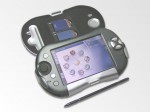 If gaming was taking a while to work on cell phones, then it would seem Palm Pilots wouldn’t get gaming right at all. Take the Tapwave Zodiac for instance. I won’t go into detail, but here are the basics: the unit played MP3s and video, ran on a version of the Palm OS, and competed with the Sony PSP and Nintendo DS. Unsurprisingly, it was discontinued in 2005, 2 years after its release. Also of interest to note was Tiger Telematics’s(not to confused with Tiger Electronics) Gizmondo. The unit which never saw a U.S. Release was launched in 2005 and discontinued less than a year later after selling only 25,000 units driving the company into bankruptcy. Although Tiger Telematics is more famous for the antics of one of its executives, Stefan M. Eriksson. Mr. Eriksson became famous not for the Gizmondo, but for wrecking a 2 million dollar sports car while driving under the influence. Later it was revealed that he had links to organized crime in Sweden, and that the car he crashed was suspected to have been stolen. Ouch. Read more about it here.
If gaming was taking a while to work on cell phones, then it would seem Palm Pilots wouldn’t get gaming right at all. Take the Tapwave Zodiac for instance. I won’t go into detail, but here are the basics: the unit played MP3s and video, ran on a version of the Palm OS, and competed with the Sony PSP and Nintendo DS. Unsurprisingly, it was discontinued in 2005, 2 years after its release. Also of interest to note was Tiger Telematics’s(not to confused with Tiger Electronics) Gizmondo. The unit which never saw a U.S. Release was launched in 2005 and discontinued less than a year later after selling only 25,000 units driving the company into bankruptcy. Although Tiger Telematics is more famous for the antics of one of its executives, Stefan M. Eriksson. Mr. Eriksson became famous not for the Gizmondo, but for wrecking a 2 million dollar sports car while driving under the influence. Later it was revealed that he had links to organized crime in Sweden, and that the car he crashed was suspected to have been stolen. Ouch. Read more about it here.
The Modern Era
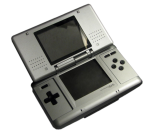 Nintendo decided to change the handheld world once again with the release of the Nintendo DS. The DS stood for Dual Screen. The unit opened in a fliptop laptop style, and there was a top screen, and a bottom. The unit included a stylus, which could be used on the bottom screen. The unit came with a built-in Pictochat program where users could draw messages and send them over to each other via the unit’s wireless connection. The unit’s stylus was used for everything from menu interaction to character movement, and the two screens had a variety of uses as well. Some used them as an extra menu, others used them to expand the playfield, and others used them to display player data, much like the Dreamcast VMUs. Although the unit could play Game Boy Advance games (and some games, such as Guitar Hero used the GBA cartridge slot for extra peripherals and connectivity), it could no longer play Game Boy or Game Boy Color games. In true Nintendo fashion, Nintendo released a number of remakes of the unit. The Nintendo DS Lite was a smaller version of the unit with a slightly larger screen, and the Nintendo DSI, which was released last summer included a redesigned menu interface, AAC audio playback, SD Card Support, two cameras, and an online shop similar to the Wii’s shop channel. Sadly, the unit omitted the Game Boy Advance slot, and there is only one DSI exclusive game, the little known System Flaw. Even so, Nintendo managed to retain its dominance over the handheld scene, with titles such as Mega Man ZX, Nintendogs, Mario and Luigi: Super Star Saga, and Contra 4.
Nintendo decided to change the handheld world once again with the release of the Nintendo DS. The DS stood for Dual Screen. The unit opened in a fliptop laptop style, and there was a top screen, and a bottom. The unit included a stylus, which could be used on the bottom screen. The unit came with a built-in Pictochat program where users could draw messages and send them over to each other via the unit’s wireless connection. The unit’s stylus was used for everything from menu interaction to character movement, and the two screens had a variety of uses as well. Some used them as an extra menu, others used them to expand the playfield, and others used them to display player data, much like the Dreamcast VMUs. Although the unit could play Game Boy Advance games (and some games, such as Guitar Hero used the GBA cartridge slot for extra peripherals and connectivity), it could no longer play Game Boy or Game Boy Color games. In true Nintendo fashion, Nintendo released a number of remakes of the unit. The Nintendo DS Lite was a smaller version of the unit with a slightly larger screen, and the Nintendo DSI, which was released last summer included a redesigned menu interface, AAC audio playback, SD Card Support, two cameras, and an online shop similar to the Wii’s shop channel. Sadly, the unit omitted the Game Boy Advance slot, and there is only one DSI exclusive game, the little known System Flaw. Even so, Nintendo managed to retain its dominance over the handheld scene, with titles such as Mega Man ZX, Nintendogs, Mario and Luigi: Super Star Saga, and Contra 4.
 A few months after the DS, Sony released the Playstation Portable, a handheld device which perhaps out of all of Nintendo’s competitors, had the best success. Of course this wasn’t saying much, but at 5 years and counting, it lasted much longer than the Game Gear, Wonderswan, and the TurboExpress. Not only did the PSP’s library include ports of PS2 and PS3 games, but it also included several original titles and series installments. Games such as Metal Gear Solid Peace Walker and God Of War: Chains of Olympus do a great job of showing that the handheld could stack up to what the dig boys were offering, and games such as 30 Minute Hero gave the system a unique identity of its own. The unit was $249 at launch time, although it wasn’t a big deal. It drained power rather quickly, but it included a built-in battery and a cable which could quickly recharge the unit (as you see, power usage has gotten better since the days of the Game Gear sucking up AA batteries). The PSP’s games were primarily released on the Universal Media Disc format, a new format Sony tried to push for movies and entertainment as well. As such several studios released movies, cartoons, and TV shows on the format, and there were even porn titles available for the system. Unfortunately, the UMD as a media format wasn’t getting over well, as it UMDs didn’t have as much storage as DVDs, so many studios had to cut out DVD extras to get their releases to fit on UMD, and really, the PSP was the only device available that could play UMDs. Many studios pulled out UMD support as it just wasn’t feasible for consumers to buy a film on scaled down UMD when they could get it on DVD for roughly the same price in most cases. On the bright side, the unit supported expandable memory with the SD Pro Duo Expansion slot, wireless connectivity, and online multiplayer. When the PS3 was released, the two systems were integrated with each other, and users could access an online store where they can purchase titles similar to the Xbox Live marketplace and Virtual Console. The system went through a few revisions of its own. The PSP 2000 and 3000 series made the unit smaller, with the latter changing around button placement, while the ill received PSP-Go omitted the UMD slot to encourage digital download of games. It has an on-board 16 gig flash memory and can support up to 32 gigs via a Micro SD card. However, the unit carried a higher price tag than the 2000/3000 units and there was no way to transfer UMD titles to the system, so it’s not hard to see why this isn’t exactly flying off store shelves. Even with this mishap, the PSP remains the most successful Non-Nintendo handheld console. The system is also hit amongst various homebrew developers. Make that would be, if not for Sony’s constant stream of firmware updates.
A few months after the DS, Sony released the Playstation Portable, a handheld device which perhaps out of all of Nintendo’s competitors, had the best success. Of course this wasn’t saying much, but at 5 years and counting, it lasted much longer than the Game Gear, Wonderswan, and the TurboExpress. Not only did the PSP’s library include ports of PS2 and PS3 games, but it also included several original titles and series installments. Games such as Metal Gear Solid Peace Walker and God Of War: Chains of Olympus do a great job of showing that the handheld could stack up to what the dig boys were offering, and games such as 30 Minute Hero gave the system a unique identity of its own. The unit was $249 at launch time, although it wasn’t a big deal. It drained power rather quickly, but it included a built-in battery and a cable which could quickly recharge the unit (as you see, power usage has gotten better since the days of the Game Gear sucking up AA batteries). The PSP’s games were primarily released on the Universal Media Disc format, a new format Sony tried to push for movies and entertainment as well. As such several studios released movies, cartoons, and TV shows on the format, and there were even porn titles available for the system. Unfortunately, the UMD as a media format wasn’t getting over well, as it UMDs didn’t have as much storage as DVDs, so many studios had to cut out DVD extras to get their releases to fit on UMD, and really, the PSP was the only device available that could play UMDs. Many studios pulled out UMD support as it just wasn’t feasible for consumers to buy a film on scaled down UMD when they could get it on DVD for roughly the same price in most cases. On the bright side, the unit supported expandable memory with the SD Pro Duo Expansion slot, wireless connectivity, and online multiplayer. When the PS3 was released, the two systems were integrated with each other, and users could access an online store where they can purchase titles similar to the Xbox Live marketplace and Virtual Console. The system went through a few revisions of its own. The PSP 2000 and 3000 series made the unit smaller, with the latter changing around button placement, while the ill received PSP-Go omitted the UMD slot to encourage digital download of games. It has an on-board 16 gig flash memory and can support up to 32 gigs via a Micro SD card. However, the unit carried a higher price tag than the 2000/3000 units and there was no way to transfer UMD titles to the system, so it’s not hard to see why this isn’t exactly flying off store shelves. Even with this mishap, the PSP remains the most successful Non-Nintendo handheld console. The system is also hit amongst various homebrew developers. Make that would be, if not for Sony’s constant stream of firmware updates.
The Future
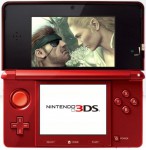 The handheld market is looking good for the future as well. Nintendo has recently unveiled the Nintendo 3DS, a 3D version of the Nintendo DS. The graphics seem to be on par to at least the PS2, as games such as Metal Gear Solid 3 and Street Fighter 4 have been announced for the system. The former was even being shown on the unit as a tech demo. With the system to be released early next year, Nintendo looks poised to retain its control over the market.
The handheld market is looking good for the future as well. Nintendo has recently unveiled the Nintendo 3DS, a 3D version of the Nintendo DS. The graphics seem to be on par to at least the PS2, as games such as Metal Gear Solid 3 and Street Fighter 4 have been announced for the system. The former was even being shown on the unit as a tech demo. With the system to be released early next year, Nintendo looks poised to retain its control over the market.
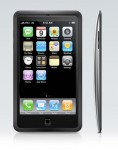 Meanwhile with the advent of smartphones and 3G cellular networks, mobile gaming is on the rise. The Iphone is making several advances in this field, with games such as Plants vs Zombies and Doom Resurrection being available on the AppStore. The Zune Marketplace isn’t far behind either. Thanks to the XNA platform, developers can create their own games for Zune and Zune HD. Google Android is another mobile phone platform that is making strides in open-source tech. The Android Marketplace is expanding often, with new titles showing up.
Meanwhile with the advent of smartphones and 3G cellular networks, mobile gaming is on the rise. The Iphone is making several advances in this field, with games such as Plants vs Zombies and Doom Resurrection being available on the AppStore. The Zune Marketplace isn’t far behind either. Thanks to the XNA platform, developers can create their own games for Zune and Zune HD. Google Android is another mobile phone platform that is making strides in open-source tech. The Android Marketplace is expanding often, with new titles showing up.
Gee, for gaming that can fit in your pocket, this article sure packs a lot. Now that you’re finally done reading this, get out there, and grad some fresh air. Oh, and you can take your Nintendo DS or Sony PSP with you if you want.


 PS3
PS3
 Famicom Dojo
Famicom Dojo KEEP PLAYING
KEEP PLAYING KEEP PLAYING: Rewind
KEEP PLAYING: Rewind Powet Toys
Powet Toys Powetcast
Powetcast Hitchhiker's Guide POWETcast
Hitchhiker's Guide POWETcast
















